|
|
1.0 Thesis Statement
This thesis will explore architectural intervention for coastal cities and water to coexist in the rising sea level scenario. Apart from reconnecting the city, the project would aim to explore a new dimension to connect between land and sea.
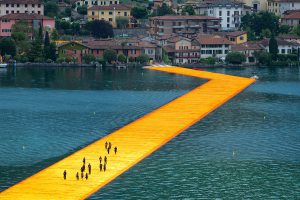
The Floating Piers by Christo
2.0 Why
Rising sea level continuously poses a long-term existential danger to the coastal cities such as Boston, Miami and New York due to global warming. According to “Climate Central”, if the global temperatures rise 4 degrees Celsius, the rising sea levels will raise to 8.9m. In this scenario, the water level shallow up our neighborhoods and cultural icons in Hong Kong and other coastline cities like Shanghai.
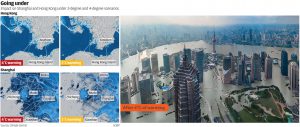
Rising sea level set to displace 45 million people in Hong Kong, Shanghai and Tianjin if earth warms 4 degrees from climate change by South China Morning Post 2015
“Climate Central” further explains, due to climate change, storm events are predicted to occur more frequently and with greater intensity. When major storm were hit the coastline cities during high tide, the region could experience sudden disastrous impact similar to those in New York during Hurricane Sandy in 2012.
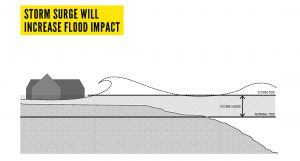
The Storm surge inpact study by “Sea Change Boston”
3.0 What
3.1 Architectural strategy study
There have been studies on how architecture can minimize the impacts of the rising sea level and storm surge. In “Sea Change Boston” research, a group of US based architects introduces certain options for urban habitation based on the sea level change and storm surge to tackle the rising sea level: keep water out, move to higher ground or adapt to live with water.
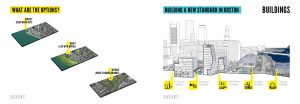
The architectural solution proposed by “Sea Change Boston”
3.2 Risk/ Change study
A group of scientist in Austrian “Climate Council” published a report “ Counting the cost: Climate change and coastal flooding” which states the rising sea level affects house, roads, cultural sites, gardens, community facilities and ecosystems. Our current cities will not function when water flood in. Looking back at the event of Hurricane Sandy in 2012, the New York Stock Exchange closed for the first time since 1888 and the storm surge flooded New York City’s subway tunnels and inundated the runways at La Guardia and Kennedy airports. A multiple threats would be posed to the existing nature, like Sea grasses and mangroves provide extremely important habit for many marine species. They will be at risk due to the saltwater inundation due to the rising sea level.
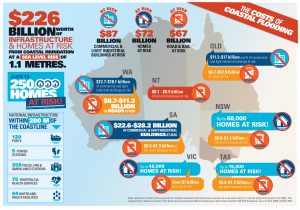
“How many infrastructure and home will be at rise at sea level rise of 1.1m” conducted by “Climate Council”
4.0 Description of Project
Further to the research finding, this thesis will explore an architectural intervention for the water and our coastal cities to co-exist. After precedents exploration, theories and materiality studies, the thesis could be to design a prototype habitat for coastal cities with its possibility to be expanded to a larger scale according to different site contexts.
This thesis will conduct a series of research on the risk that happen in rising sea level scenario and experiments on the boundary of water and land to come up with a proper relationship between sea and land.
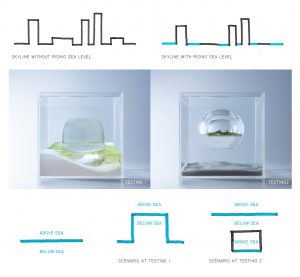
5.0 Methodology (How)
- Risk/ Change research – To identify the risk in the perspective of time (ie. Continuous, periodical and sudden change of sea level) and in scale, i.e. S(point/ Line) M (Surface) L (Volume).
- Examine on the boundary between water and land – To explore the possibility of the sea/ land relationship and identify their benefits. Model will be made in the experimental progress.
- Feasibility study – Draw hypothesis on a selected sea level and site; identify changes, potential risks and needs in urban scale. A process to be elaborated in mappings and drawings.
- Implication of the boundary experiment in the selected site – to combine the conclusion and findings, a prelim architectural design for the prototype habitat will be proposed.
6.0 Potential theory
- Gissen, David. Subnature: Architecture’s Other Environments: Atmospheres, Matter, Life. New York: Princeton Architectural Press, 2009. Print.
- Frampton, Adam; Solomon, Jonathan D.; Wong, Clara. Cities without ground: A Hong Kong Guidebook.
- Koolhass, Rem; Mau, Bruce; Werlemann, Hans. S,M,L,XL. New York: Princeton Architectural Press, 1997. Print.
- Frampton, Kenneth. Towards a Critical Regionalism: Six Points for an Architecture of Resistance. , in “Anti-Aesthetic. Essays on Postmodern Culture.” Seattle: Bay Press 1983
Citation:
1. Christo and Jeanne-Claude, The Floating Piers. 2016, colour print 1000×600. Available from The project: The Floating Piers. http://www.thefloatingpiers.com/.
2. Li Jing; Agence France-Presse, Rising sea level set to displace 45 million people in Hong Kong, Shanghai and Tianjin if earth warms 4 degrees from climate change. 2015. Source: SCMP. 2015, Colour Rendering print,1024×768. Available from SCMP. http://www.scmp.com/print/news/hong-kong/health-environment/article/1877284/rising-sea-levels-set-displace-45-million-people
3. Sasaki Associates, Sea Change: Boston. 2015 Source: Sasaki. 2015, Colour print, 1024×768. Available from Sasaki. http://www.sasaki.com/project/360/sea-change-boston/
4. Climate Council, Counting the cost: Climate change and coastal flooding. 2014. Colour print 210×297. Available from Climate Council. http://www.climatecouncil.org.au/.
|